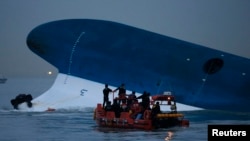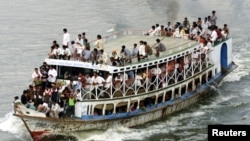The recent ferry accident in South Korea has focused renewed attention on the safety of the vessels, which transport 2 billion passengers, 250 million vehicles and 32 million trailers across the globe each year.
While ferries are among the safest forms of transportation in the United States and Europe, they have caused thousands of deaths in the developing world.
In places such as Bangladesh, with its more than 250 waterways, ferries are a major and cost-efficient means of transport.
They are also notoriously dangerous. Between April 2003 and July 2003 alone, more than 1,200 Bangladeshis died in six separate ferry incidents. Those figures are only estimates, because ferries are often overcrowded and passenger lists are rarely kept.
At least 800 to 1,000 people die every year in ferry accidents, Roberta Weisbrod, executive director of the Worldwide Ferry Safety Association, told VOA.
“And these numbers represent only the victims whose bodies are found, not the missing, so the numbers of deaths could actually be much higher,” she said.
Causes of ferry accidents
Debate is raging over what could have caused the ferry Sewol to capsize April 16 with 476 passengers and crew onboard, including at least 300 high school students on a field trip.
As of late Friday, the number of confirmed deaths reached 183, with a 119 reported missing.
The official death toll had reached 157 as of Wednesday, with more than 150 people still missing.
The ferry association, in partnership with Interferry, an organization representing the global ferry industry, has collected data and documented shipping accidents across the globe since 2000. She concluded that most ferry accidents have at least one of four causes:
“One, the vessels themselves are often old or inappropriate,” Weisbrod said. “Two, overcrowding. Three, sudden hazardous weather. And finally, the human factor — an inadequately trained crew.”
Reports suggest that the Sewol accident may have resulted from a “perfect storm” of factors: An inexperienced third mate was steering the craft in treacherous waters at high speed.
Cash-strapped ship owners might have overloaded the passenger ferry with cargo, which might have if the vessel was steered sharply. That, in turn, might have caused the vessel to list dangerously to one side.
At least one report, by Korea’s Arirang TV, suggests the ferry’s tracking system may have blacked out for a time.
The Sewol was manufactured in Japan in 1994 and purchased by South Korea’s Chonghaejin Marine Co. 2012. Its new owners subsequently renovated the ferry, adding another deck to accommodate more passengers.
This increased the vessel’s weight by 239 tons – enough, according to one report, to shift the Sewol’s center of gravity and throw it off balance.
The same report says the ferry passed inspection in February.
Regulation compliance spotty
The International Maritime Organization (IMO), created in 1948, is the specialized United Nations agency that oversees shipping safety and efficiency by setting standards, including those for vessels’ design, construction, equipment and staffing.
But these standards only apply to vessels trading or operating between countries, not national shipping or ferry operations.
While many countries apply IMO conventions to their domestic operations, some lack the resources to enforce regulations and others simply ignore them.
The results can be devastating.
In February 2006, more than 1,000 died when the Egyptian ferry al-Salam Boccaccio 98, carrying more than 1,400 religious pilgrims and crew from Saudi Arabia to Egypt, caught fire and sank in the Red Sea.
“There was a fire on one of the car decks,” Charles Cushing, adjunct professor at the World Maritime University and expert in marine safety, told VOA. “And so the crew went in and just began to pump seawater into that deck, far more water than it could hold.”
Cushing said the captain called the ferry’s owners and asked whether he should continue toward to Egypt or turn back to the Saudi port of Duba, where the voyage had originated.
“The owners said, ‘Keep going, don’t turn back, you can make it,’” Cushing said. “Eventually, the captain turned to go back and when he did so, all that water ran to one side and the ship rolled over.”
Investigators later determined that the ferry had not met minimum safety standards and that maritime safety authorities allowed it to sail anyway.
“Most maritime-developed countries are rather responsible about carrying out investigations into ferry accidents and do so promptly,” Cushing said. “But others — and I won’t name names here — start investigations but never seem to finish them.
"And others never bother to investigate at all and simply sweep these accidents under the rug,” Cushing said.
Efforts to improve ferry safety
Interferry is working with IMO and developing countries to improve ferry safety. So far, the two groups have brought together safety officials to share best practices.
In Bangladesh, they sponsored a second annual ferry design competition and tested a training course designed for ferry crews, which is now available online.
IMO also led the planning and staging of two forums on ferry safety in Indonesia, the Pacific Region and China. Another is planned for Africa.
Weisbrod said the organizations are exploring whether electronic media — interactive games, CDs, even cellphone or iPad applications — could help educate crew members in better safety practices.
While ferries are among the safest forms of transportation in the United States and Europe, they have caused thousands of deaths in the developing world.
In places such as Bangladesh, with its more than 250 waterways, ferries are a major and cost-efficient means of transport.
They are also notoriously dangerous. Between April 2003 and July 2003 alone, more than 1,200 Bangladeshis died in six separate ferry incidents. Those figures are only estimates, because ferries are often overcrowded and passenger lists are rarely kept.
At least 800 to 1,000 people die every year in ferry accidents, Roberta Weisbrod, executive director of the Worldwide Ferry Safety Association, told VOA.
“And these numbers represent only the victims whose bodies are found, not the missing, so the numbers of deaths could actually be much higher,” she said.
Causes of ferry accidents
Debate is raging over what could have caused the ferry Sewol to capsize April 16 with 476 passengers and crew onboard, including at least 300 high school students on a field trip.
As of late Friday, the number of confirmed deaths reached 183, with a 119 reported missing.
The official death toll had reached 157 as of Wednesday, with more than 150 people still missing.
The ferry association, in partnership with Interferry, an organization representing the global ferry industry, has collected data and documented shipping accidents across the globe since 2000. She concluded that most ferry accidents have at least one of four causes:
“One, the vessels themselves are often old or inappropriate,” Weisbrod said. “Two, overcrowding. Three, sudden hazardous weather. And finally, the human factor — an inadequately trained crew.”
Reports suggest that the Sewol accident may have resulted from a “perfect storm” of factors: An inexperienced third mate was steering the craft in treacherous waters at high speed.
Cash-strapped ship owners might have overloaded the passenger ferry with cargo, which might have if the vessel was steered sharply. That, in turn, might have caused the vessel to list dangerously to one side.
At least one report, by Korea’s Arirang TV, suggests the ferry’s tracking system may have blacked out for a time.
The Sewol was manufactured in Japan in 1994 and purchased by South Korea’s Chonghaejin Marine Co. 2012. Its new owners subsequently renovated the ferry, adding another deck to accommodate more passengers.
This increased the vessel’s weight by 239 tons – enough, according to one report, to shift the Sewol’s center of gravity and throw it off balance.
The same report says the ferry passed inspection in February.
Regulation compliance spotty
The International Maritime Organization (IMO), created in 1948, is the specialized United Nations agency that oversees shipping safety and efficiency by setting standards, including those for vessels’ design, construction, equipment and staffing.
But these standards only apply to vessels trading or operating between countries, not national shipping or ferry operations.
While many countries apply IMO conventions to their domestic operations, some lack the resources to enforce regulations and others simply ignore them.
The results can be devastating.
In February 2006, more than 1,000 died when the Egyptian ferry al-Salam Boccaccio 98, carrying more than 1,400 religious pilgrims and crew from Saudi Arabia to Egypt, caught fire and sank in the Red Sea.
“There was a fire on one of the car decks,” Charles Cushing, adjunct professor at the World Maritime University and expert in marine safety, told VOA. “And so the crew went in and just began to pump seawater into that deck, far more water than it could hold.”
Cushing said the captain called the ferry’s owners and asked whether he should continue toward to Egypt or turn back to the Saudi port of Duba, where the voyage had originated.
“The owners said, ‘Keep going, don’t turn back, you can make it,’” Cushing said. “Eventually, the captain turned to go back and when he did so, all that water ran to one side and the ship rolled over.”
Investigators later determined that the ferry had not met minimum safety standards and that maritime safety authorities allowed it to sail anyway.
“Most maritime-developed countries are rather responsible about carrying out investigations into ferry accidents and do so promptly,” Cushing said. “But others — and I won’t name names here — start investigations but never seem to finish them.
"And others never bother to investigate at all and simply sweep these accidents under the rug,” Cushing said.
Efforts to improve ferry safety
Interferry is working with IMO and developing countries to improve ferry safety. So far, the two groups have brought together safety officials to share best practices.
In Bangladesh, they sponsored a second annual ferry design competition and tested a training course designed for ferry crews, which is now available online.
IMO also led the planning and staging of two forums on ferry safety in Indonesia, the Pacific Region and China. Another is planned for Africa.
Weisbrod said the organizations are exploring whether electronic media — interactive games, CDs, even cellphone or iPad applications — could help educate crew members in better safety practices.









